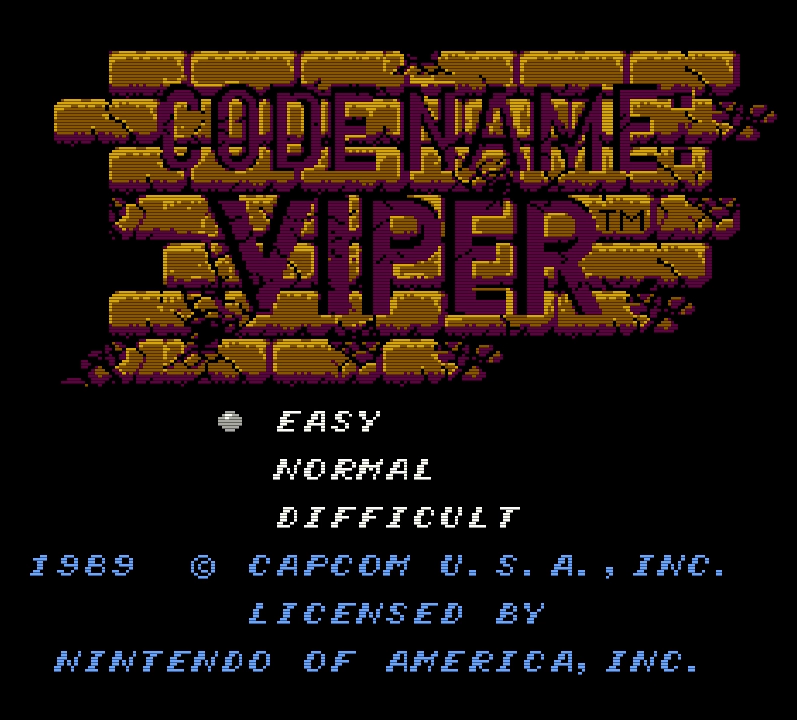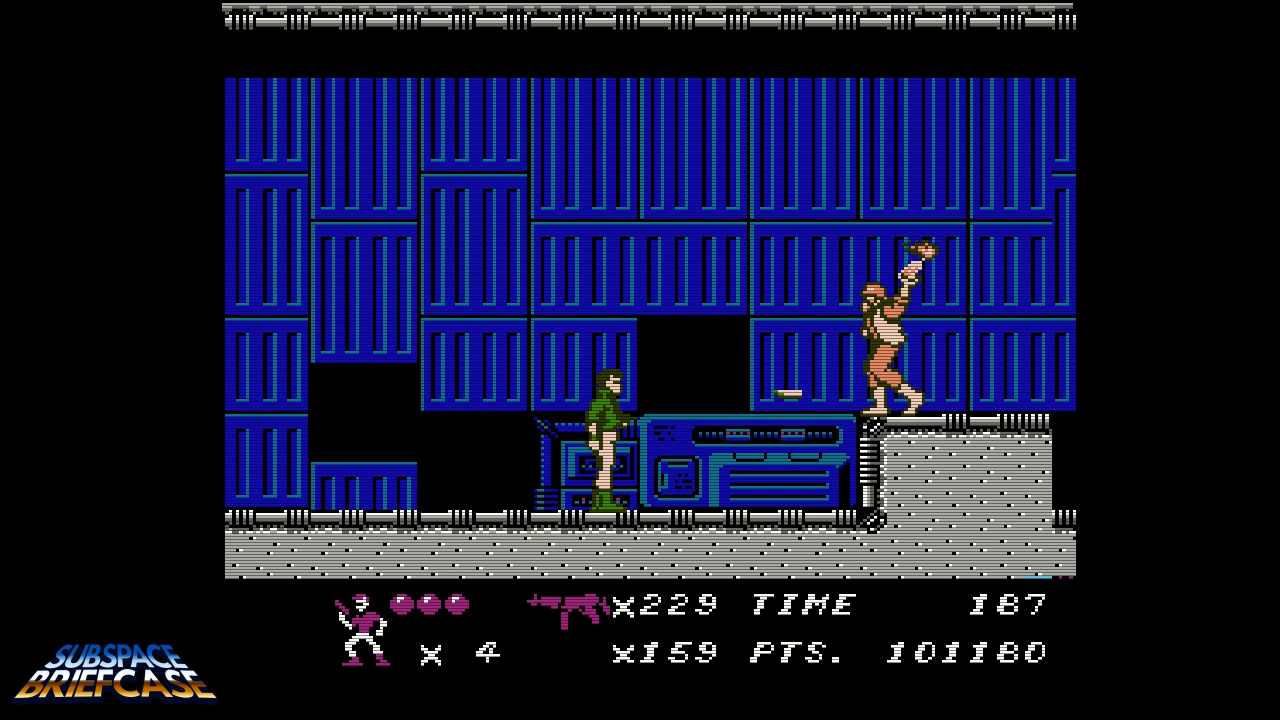 Code Name: Viper
Code Name: Viper
Nintendo Entertainment System, 1990
Developer: Arc System Works
Publisher: Capcom
Last time, we talked about the underrated gameplay of Capcom’s Code Name: Viper. Today, we’ll be talking about its inspirations, or perhaps more accurately, its source material.
It would be diplomatic to say that Code Name: Viper was heavily inspired by Namco’s Rolling Thunder. It would be accurate to say that nearly nearly every aspect of Code Name: Viper’s design was stolen from Rolling Thunder.
Originally released to arcades in late 1986, Rolling Thunder puts the player in control of Albatross, a secret agent on a quest to rescue his partner, Leila. But Rolling Thunder’s epic backstory isn’t relevant to this discussion. If you’d like to learn more about Rolling Thunder, you should read Kurt Kalata’s excellent writeup over at Hardcore Gaming 101. And after you’ve read that, head over to USGamer and listen to the fantastic episode of Retronauts Micro on the entire Rolling Thunder series. Done? Good.
 What is relevant to this discussion is that in 1989, Namco decided to to port Rolling Thunder to the Famicom/NES. Tengen would publish the game in the US, in one of its infamous, black, off-brand cartridges. If the Internet is to be believed, the developer tasked with porting Rolling Thunder to Nintendo’s console (at least in part) was none other than Arc System Works. Today, Arc is well-known in gaming circles as the developer of the increasingly eccentric Guilty Gear franchise of fighting games. Back in 1989, however, Arc would have been just a plucky little upstart development house, somewhere in the middle of its first or second year of existence.
What is relevant to this discussion is that in 1989, Namco decided to to port Rolling Thunder to the Famicom/NES. Tengen would publish the game in the US, in one of its infamous, black, off-brand cartridges. If the Internet is to be believed, the developer tasked with porting Rolling Thunder to Nintendo’s console (at least in part) was none other than Arc System Works. Today, Arc is well-known in gaming circles as the developer of the increasingly eccentric Guilty Gear franchise of fighting games. Back in 1989, however, Arc would have been just a plucky little upstart development house, somewhere in the middle of its first or second year of existence.
Arc’s port of Rolling Thunder isn’t bad, so much as it is drab and unrefined. The game’s color palette is remarkably restrained: everything looks like it was originally optimized to run on a CGA monitor. And in case you’re under 30 and that reference flew over your head, just take a look:
Until the color green makes its appearance in the third level, you couldn’t be blamed for thinking that Arc had intentionally restricted themselves to blues, whites, and blacks. Thankfully, things get a little more varied and colorful as the game progresses.

While Rolling Thunder for the NES borders on indisputably ugly, it plays remarkably well. Generally speaking, the action in Rolling Thunder takes place across two parallel planes – a high plane and a low plane. Albatross and the legion of masked enemies that stand in his way can freely travel between those two planes by way of a perpendicular leap. As Albatross has the smallest of life bars, the player is forced to dart between both planes, around cover, and into hidden doors in order to get the drop on enemies without taking any damage. It’s a nice little gameplay cocktail which makes for some fairly exciting action. One can’t help but think that Arc had the Rolling Thunder formula fairly close to perfected. If only they had another bite at the apple, what might they have accomplished?

As luck would have it, we know the answer to that question. Code Name: Viper is Arc’s second bite. You may have noticed that the last paragraph was comprised entirely of re-purposed and slightly altered sentences from last week’s post. That’s because Code Name: Viper is comprised entirely of re-purposed and slightly altered gameplay concepts and graphics from Rolling Thunder.
You see, in 1990, despite being an extremely prolific developer in its own right, as well as the owner of some of the hottest video game franchises on the planet, Capcom inexplicably decided that it needed to publish what amounted to a port of Rolling Thunder on the NES.

Perhaps this was some sort of jab at its arcade competitor, Namco? The world may never know.

Again, if the Internet is to be believed, Capcom hired the uniquely qualified Arc System Works to do the grunt work. The end result: Code Name: Viper, which is both highly derivative of Rolling Thunder, yet refined and improved in nearly every single way.
The similarities in both of Arc’s games are readily apparent. All you have to do is compare the sprites for Mr. Smith and Albatross:
They both fire their machine guns from the same posture;
they both share the same awkward jumping pose;
they have nearly identical falling animations;
and, hell, they are both wearing the same set of disturbingly flesh-toned, high-waisted pants. Apparently, and unfortunately, Arc felt they’d accomplished all they needed to accomplish in the realm of covert operative leg-wear.
The similarities extend beyond character sprites as well. Just compare the second level of Rolling Thunder…
with the second level of Code Name: Viper:
Even the interstitial sequences which feature the bad guys watching a computer monitor were taken from Rolling Thunder…
… though they’ve got far more polish in Code Name Viper.
This is just the tip of the iceberg, really; the enemy designs, the music, the power-ups – Code Name: Viper lifted so much from Rolling Thunder that it probably threw its back out in the process. It is for this reason that Code Name: Viper has been dismissed as little more than a ripoff, and perhaps rightfully so.
But here’s the thing: if Code Name: Viper is simply Rolling Thunder under another name, it’s indisputably the best version of Rolling Thunder on the NES. Arc’s second crack at Rolling Thunder’s particular brand of spy-themed action improves on their first effort in nearly every single way: the graphics are more detailed, the control is tighter, and the music is catchier. It’s the Rolling Thunder that Namco should have published in the first place. Sure, you can choose to view Code Name: Viper as a ripoff, but I choose to view it as an example of a developer revisiting its freshman efforts and improving upon them in virtually every single way. Capcom copied Namco; Arc merely copied itself.
Regardless of how you come out on Arc’s peculiar brand of sub-contracted self-plagiarism, it’s hard to dispute that it resulted in quality release in Code Name: Viper. It’s the closest thing to a South American vacation you’ll find on an 8-bit console, and it’s a fair shake more pleasant to look at than its drab predecessor. Skip the originator and go right to the imitator.
Unless you’ve got a Genesis, that is… but that is a story for another time.












